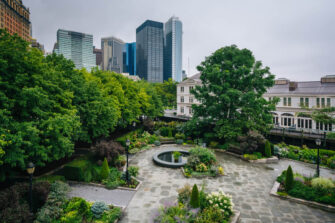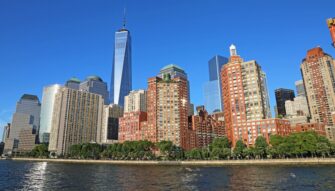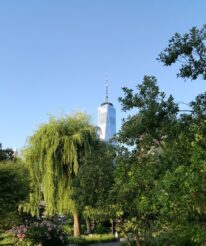The Battery Personal Injury Attorney

The Battery, formerly known as Battery Park, is a 25-acre public park that faces New York Harbor at the southern tip of Manhattan in New York City. The area is named for the protective artillery batteries located there in the city’s early years. The park contains several memorials, the SeaGlass Carousel and Castle Clinton, a former fort that housed the New York Aquarium in the early 20th century.
Key Features of the Battery
Table of Contents
Ferries to the Statue of Liberty and Ellis Island depart from and return to the Battery. The park is adjacent to South Ferry Terminal, from where the Staten Island Ferry operates. Northwest of the park is the planned community Battery Park City.
The largest structure in the Battery is Castle Clinton, which was a fort before the War of 1812. It has also served as a beer garden, a theatrical venue and an immigration depot. It is now managed by the National Park Service and contains the ticket office for the Liberty and Ellis Island ferries.
 The Battery also contains Hope Garden, a memorial dedicated to AIDS victims; the East Coast Memorial, commemorating U.S. servicemen who died in the Battle of the Atlantic during World War II; and the Korean War Memorial. Visitors also can see the American Merchant Mariners’ Memorial sculpture from the Battery, located on a stone breakwater in the Hudson River. Dedicated in 1991, the bronze sculpture shows four World War II seamen with their sinking vessel after a U-boat attack. High tide covers one of them reaching up from the water.
The Battery also contains Hope Garden, a memorial dedicated to AIDS victims; the East Coast Memorial, commemorating U.S. servicemen who died in the Battle of the Atlantic during World War II; and the Korean War Memorial. Visitors also can see the American Merchant Mariners’ Memorial sculpture from the Battery, located on a stone breakwater in the Hudson River. Dedicated in 1991, the bronze sculpture shows four World War II seamen with their sinking vessel after a U-boat attack. High tide covers one of them reaching up from the water.
The fish-themed SeaGlass Carousel, resembling a ride through an under-the-sea garden, opened in 2015. It plays classical music adapted into contemporary styles. Rides last for about three minutes and cost $5.
History of the Battery
1626: Fort Amsterdam is built on the shores of the Battery. It becomes the administrative headquarters for the Dutch West India Company for 38 years.
1776: The Continental Army under Gen. George Washington occupies the Battery and Fort George, which had been Fort Amsterdam.
1790: The fort is demolished, and the Battery becomes a public promenade.
1811: Another fort, the West Battery (later renamed Castle Clinton, after New York Governor DeWitt Clinton), is constructed on a manmade island 300 feet from the lower shore of Manhattan. A wooden bridge connects it to Manhattan.
1824: The future Castle Clinton becomes Castle Garden, a public amphitheater, hosting a hot-air balloon ascension and circus performances.
1855: The modern Battery takes shape from landfill, connecting Castle Garden to the mainland. The State of New York establishes an Emigrant Landing Depot here, which processes about 8 million immigrants over the next 35 years, including Harry Houdini, Nikola Tesla, Emma Goldman and Joseph Pulitzer.
1896: Castle Garden is renovated and reopens as the New York Aquarium.
1941 to 1952: The park is closed during construction of the Brooklyn-Battery Tunnel and Battery Park Underpass, then is expanded by two acres.
1966: Castle Clinton is added to the National Register of Historic Places.
1982: New York State includes the Battery within a group of historic waterfront sites.
1994: The Battery Conservancy, a not-for-profit educational corporation to rebuild and revitalize the Battery and Castle Clinton, is created.
2015: The New York City Department of Parks and the Battery Conservancy change the park’s name from “Battery Park” to “The Battery.”
Location & Tourism
 The Battery runs south of State Street and Battery Place in Manhattan. It is adjacent to Robert F. Wagner Jr. Park, which contains the Museum of Jewish Heritage.
The Battery runs south of State Street and Battery Place in Manhattan. It is adjacent to Robert F. Wagner Jr. Park, which contains the Museum of Jewish Heritage.
Interesting Facts About the Battery
- Castle Clinton temporarily displayed part of a 200-year-old stone wall discovered in 2005 during the construction of the new South Ferry subway station. The wall was determined to be the oldest manmade structure still in place in Manhattan.
- German artist Fritz Koenig’s 1971 bronze sculpture The Sphere, a symbol of world peace, was displayed in the Battery from 2002 to 2017 next to the eternal flame, a memorial for those who died during the September 11, 2001, terrorist attacks. The sculpture, damaged in the attacks, had stood at the center of the original World Trade Center plaza and is now installed in Liberty Park at the new World Trade Center.
- The James Watson House, a Federal mansion on the northern boundary of the park at State Street, is now the rectory of the Shrine of St. Elizabeth Ann Seton.
- The Battery Urban Farm, located within the park, provides farm-based learning with organically grown flowers and plants.
- The SeaGlass Carousel’s shimmery angelfish and other species are made of fiberglass. The carousel’s enclosed pavilion glows like a fish tank at night.
Directions to Belluck Law from the Battery
Belluck Law’s mesothelioma law office is located at 546 Fifth Ave., 5th Floor, in Midtown. From the Battery, get on FDR Drive north from State Street and exit at East 42nd Street (First Avenue/United Nations Plaza). Turn right into the First Avenue Tunnel, then left onto East 47th Street and left again onto Fifth Avenue. Our office also is accessible by taking the 4/5 subway train uptown from Bowling Green to Grand Central.